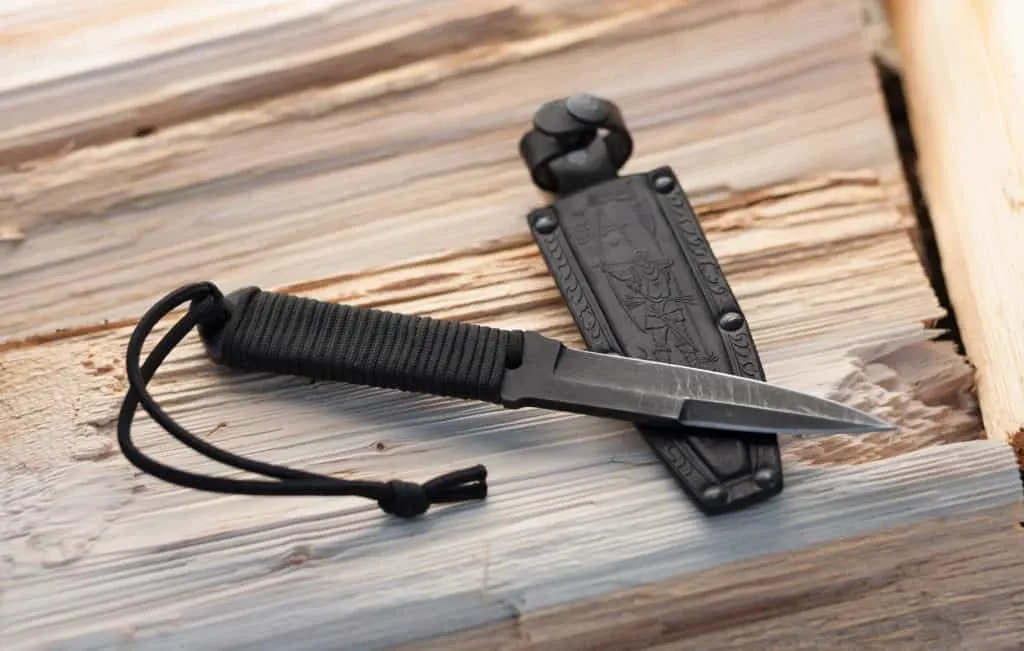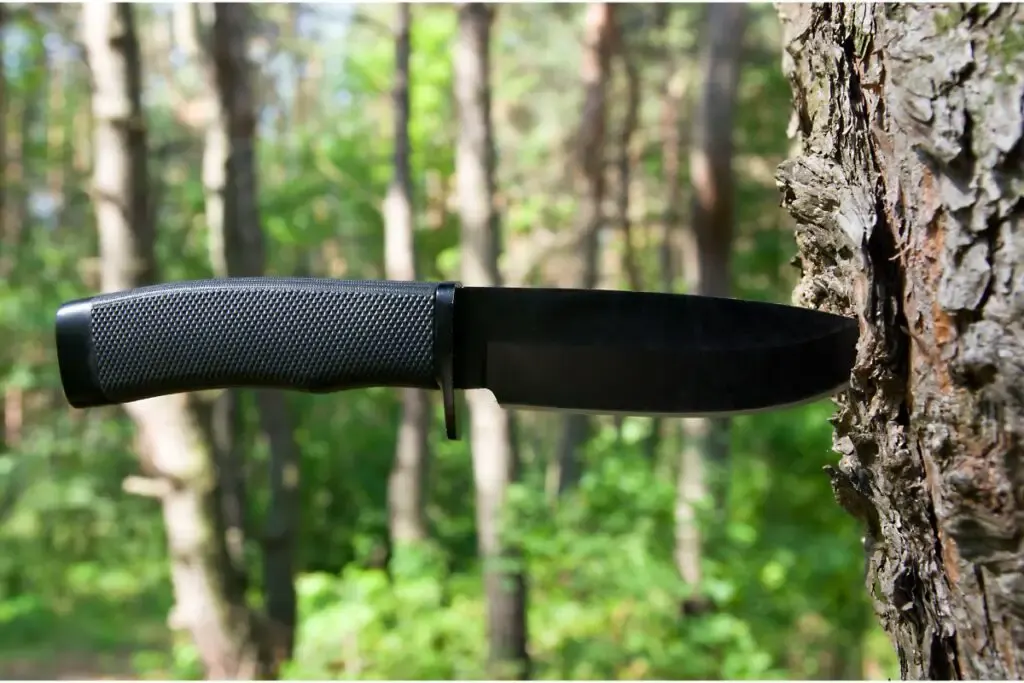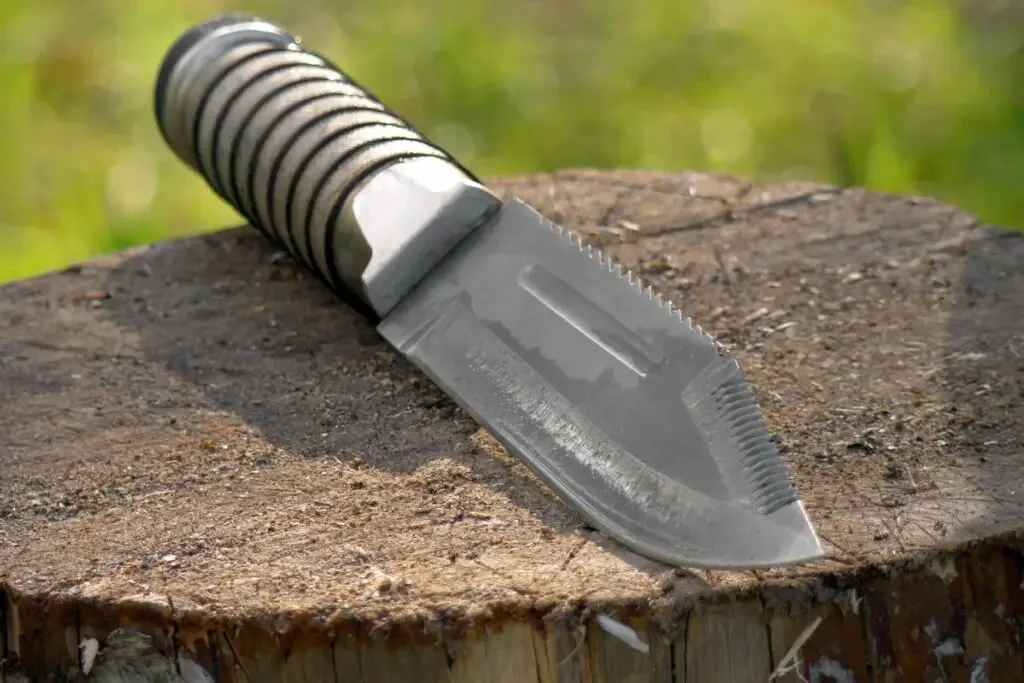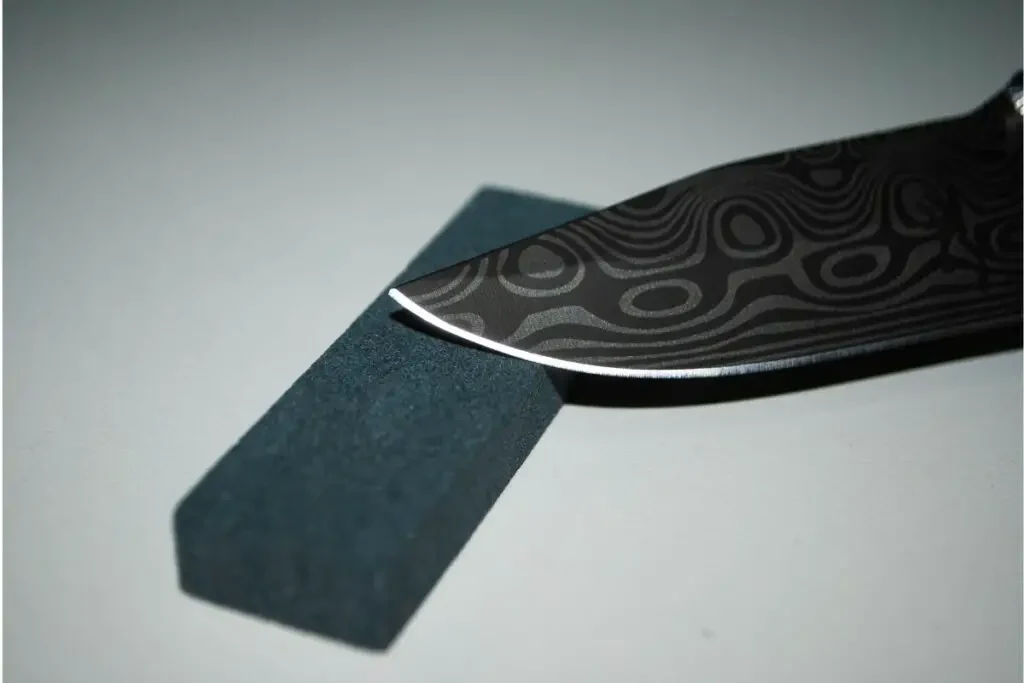As an Amazon Associate, we earn from qualifying purchases with no additional costs for you.
All knives, even those that are made from stainless steel, have the potential to stain, or patina, or even develop rust on the blade. Rust is probably the more problematic of the two since the rust will eventually eat into the metal and potentially weaken the structure of the knife. There are various ways that you can protect the surface of the steel to prevent it from rusting. Should you consider painting as one of these options to protect a knife blade?
You can paint a knife blade, but only certain paint types and methods will be suitable. For painting, powder coating is the preferred method. If the knife will be used with food, a food-safe paint and process must be used on the blade. Other coating types are available as an alternative to paint.
Painting a knife blade has more benefits than simply protecting it from corrosion. In some applications, the paint could provide a desirable non-glare characteristic, make the knife easier to clean and add visual appeal to the blade.
Due to the nature of the tasks that a knife is used for, it stands to reason that not any old paint job will do. So, what is the best way to paint a knife, and would you be able to do it at home?
If you are interested in checking out the best tactical and military knives (made by the famous US knife maker company KA-BAR) we recommend and use you can find them by clicking here (Amazon link).

Is It Possible To Paint A Knife Blade?
If you are an amateur knifemaker or simply a knife owner and are considering options to protect your knives to make them last longer, or for various other reasons, you may want to consider painting as an option.
There are only certain types of paint methods that would be suitable, but there are other coatings that will work well to protect your knife.
Paint is an acceptable coating for a knife blade, but you cannot go out to the local hardware and buy a can of spray paint to paint the knife.
The paint coating must be durable, hardwearing, and food-safe if you are using the knife to prepare food. Standard paints from a can are not suitable for this type of paint job and should not be considered as an option.
Paints applied by hand, even spray paint, go on the surface quite thick, which may not maintain the clean lines of the knife and achieve a professional finish.
While it is possible to paint a knife with any type of paint or application method, normal paint will have some drawbacks. It will scratch off the blade very easily when the knife is used, and it will also chip off if the knife is subjected to an impact.
What Is The Best Paint To Use On a Knife?

If you want to pursue the direction of paint rather than other coatings on your knife blade, powder coating is the best method to achieve and durable, professional finish to the paint job.
Powder coating is the best way to paint a knife and achieve professional, desirable results. Powder coating is durable and goes on in a very thin coat, which does not round out any edges on the knife. UV curing paint is best so that the heat treatment and temper of the knife are not compromised.
The powder coating process is when the paint is applied as a powder to the surface of the metal in a very thin layer. The powder is then baked onto the surface by heat or UV light, depending on the paint type.
The powder is normally held to the metal surface before the baking process by an electrostatic charge, which also helps to keep the layer of paint even and smooth.
The downside to powder coating is that it is not normally easily done in a home workshop since specialized equipment is needed for the application of the powder and the baking process.
Preparing A Knife For Paint
A knife that is going to be painted should generally not have a smooth, shiny surface. A smooth surface does not accept paint very well and may cause it to flake off.
The way to prepare a knife for paint is to sand it to a 220-grit finish, then soak the knife in acetone to remove any grease and oil. Remove the knife from the acetone, handling the knife with gloves. Then sandblast the surface of the metal, which gives the paint a better purchase on the steel.
The knife is now ready to accept the paint, and the paint is more likely to stick to the metal in an even layer. You may need to prepare your knife in this way before you send it off to a supplier to be powder coated, or the supplier may be willing to do this process for you for an additional fee.
Our choice: If you are interested in buying a 220 grit whetstone, we recommend and use Shapton Sharpening Ceramic Whetstone #220 (Amazon link). An alternative (cheaper) can be Naniwa #220 (Amazon link), whetstone from one of the most popular and respected companies among professional knife sharpeners. Both recommended whetstones guarantee you the best quality on the market.
Why Paint A Knife Blade?

The reasons to paint a knife could be varied and also dependant on the purpose that the knife was created for.
Reasons to paint or coat a knife could be to protect the knife from corrosion if it is going to be used where it will be exposed to high humidity conditions or chemicals that could corrode the knife.
In some instances, such as for hunting or military applications, you may want to remove the reflective nature of the metal for concealment. This can be done with paint, other coatings, or even by using acid etching to darken the blade.
Painting the knife will also reduce the friction of the knife as it passes through whatever is being cut and will allow the knife to cut more cleanly and with a smoother action.
Sometimes the reason to paint the knife is for pure aesthetics and no other reason. You may want to color the blade to better match the handle scales or change the overall look of the knife.
Even if this is your primary reason to paint the knife, it is best to choose a method that will be durable and stay on the knife for a long time.
TIP: A question often asked among knife users is: Do magnets damage knives? For a breakdown of this question click the article below!
Do Magnets Damage Knives? Here’s the Complete Answer
What Other Protective Coatings Can You Use On A Knife Blade?
Several alternative coatings can be used on a knife blade that are better options than paint. Most of these options are more durable and effective as a protective layer for the metal and offer better friction elimination characteristics than paint.
Protective coatings for a knife other than the paint can include TiCN, which is a titanium carbon coating, and DLC, a carbon coating that has similar properties to diamond and Cerakote. These coatings are tougher than paint. Other options can also include acid etching to provide a coating on the metal.
Many of the professional finishes that you see on commercially manufactured knives are not painted at all. Many of these manufacturers use a coating such as Titanium Carbon-nitride, or TiCN, or Diamond-Like Carbon, or DLC. These coatings are applied in a process called PVD or Physical Vapor Deposition.
Unfortunately, these processes require specialized machinery and equipment, which is normally outside of the scope of a home user.
If you live near a decent-sized city, you should be able to find a local supplier who would be willing to process your knives for you and coat them with one of these coatings.
However, the supplier may not be willing to do one or two knives at a time and would prefer to do larger numbers as a single batch.
If this is the case, you may have to wait until you have enough knives to make up the batch or team with some other knife makers in your area and split the cost of the coating process.
BTW: If you want to know more about Japanese and other knives and their sharpening, check out the books listed above. These books are recommended by professional sharpeners and knife makers (Amazon links):
- Japanese Kitchen Knives: Essential Techniques and Recipes
- The Knifenerd Guide to Japanese Knives
- Knife: The Culture, Craft, and Cult of the Cook’s Knife
- Sharp: The Definitive Introduction to Knives, Sharpening, and Cutting Techniques, with Recipes from Great Chefs
Cerakote As A Knife Coating
Cerakote is a coating that is made up of a compound of polymers and ceramics and is a coating that is often applied to firearms as a protective layer.
The advantage of Cerakote is that the layer is very thin, resistant to corrosion and chemicals, and it is very smooth. It is often used on the working parts of firearms, where it reduces friction by up to 80%.
This means that a knife blade that has a Cerakote coating will cut very smoothly through whatever you are cutting due to the reduced friction.
Our choice: If you want to try Cerakote coating take a look at this CERAKOTE Ceramic Coating Starter Kits (Amazon link), we did not try it yet but it is used by many knives sharpeners and has really good reviews.
Acid Etching As A Knife Coating

Acid etching is another method of protecting the knife from corrosion and discoloration. The chemical reaction produced during the etching process creates a darkened layer on the metal which protects it from corrosion.
This layer does wear off with use, and another disadvantage is that you don’t have much choice in the color that is created; it will always be a shade of black.
Knife Blade Coatings That Can Be Done At Home
Protecting a knife blade from wear and tear is a priority for all knife owners. While several commercial coatings are available, a few methods can be done at home without any specialized equipment.
I prefer oil or acid etching to place a protective coating on the blade to protect it from corrosion. While oil does not last as long as other coatings, it is easy to re-apply, and if you choose a food-safe oil, the knife is safe to use to process food.
For completeness, we will include other DIY knife blade coatings that are not only cost-effective but also quite efficient in prolonging the life of your knife.
1. Oil Coating
Materials Needed: Mineral oil or vegetable oil, clean cloth.
Procedure
- Clean the blade thoroughly to remove any dirt or grime.
- Apply a thin layer of oil evenly across the blade using a clean cloth.
- Let it sit for a few minutes before wiping off the excess.
Benefits
- Prevents rust and corrosion.
- Safe for food preparation knives.
2. Beeswax Coating
Materials Needed: Beeswax, a double boiler, and a clean cloth.
Procedure
- Melt a small amount of beeswax in a double boiler.
- Once melted, apply a thin layer of beeswax onto the blade using a clean cloth.
- Allow it to harden, forming a protective layer.
Benefits
- Natural and non-toxic.
- Provides a smooth surface, reducing friction during cutting.
3. Acid Etching
Materials Needed: Vinegar or lemon juice, and a clean cloth.
Procedure
- Clean the blade thoroughly.
- Apply a generous amount of vinegar or lemon juice onto the blade.
- Let it sit for a few hours to create a patina, which forms a protective layer.
- Rinse off the acid and dry the blade completely.
Benefits
- Creates a unique, aged look on the blade.
- Adds a layer of protection against corrosion.
4. Homemade Cerakote
Materials Needed: Cerakote kit, oven.
Procedure
- Follow the instructions provided in the Cerakote kit to prepare and apply the coating.
- Cure the coating in an oven as per the instructions.
Benefits
- Provides a hard and durable coating.
- Available in various colors for aesthetic appeal.
The downside of the Cerakote option is that the knife must be subjected to high temperatures in an oven. If the knife handle cannot withstand these temperatures, the knife must be disassembled before baking. Protecting your knife blade doesn’t always require professional help. With these DIY methods, you can easily give your knife a protective coating that enhances its lifespan and adds to its aesthetic appeal. Remember, the key to a successful coating is proper preparation and application.
Conclusion
Painting a knife needs careful preparation of the metal to receive the paint, and specialized painting will provide the best and most durable results on the blade.
When selecting paint as the coating of choice for a knife, the best option is powder coating because it is a harder and more durable paint, and the process allows for an even layer to be applied, which keeps the finish looking good.
TIP: If you want to have your pocket knife in good shape, it has to be sharp. In the article below, you will find the 4 best sharpeners for your pocket knife!
The 4 Best Knife Sharpeners For Pocket Knives
